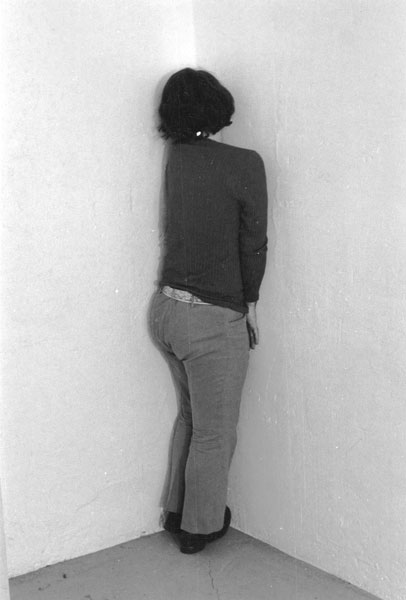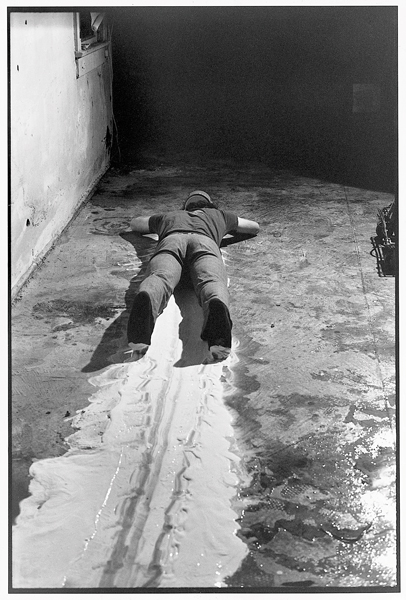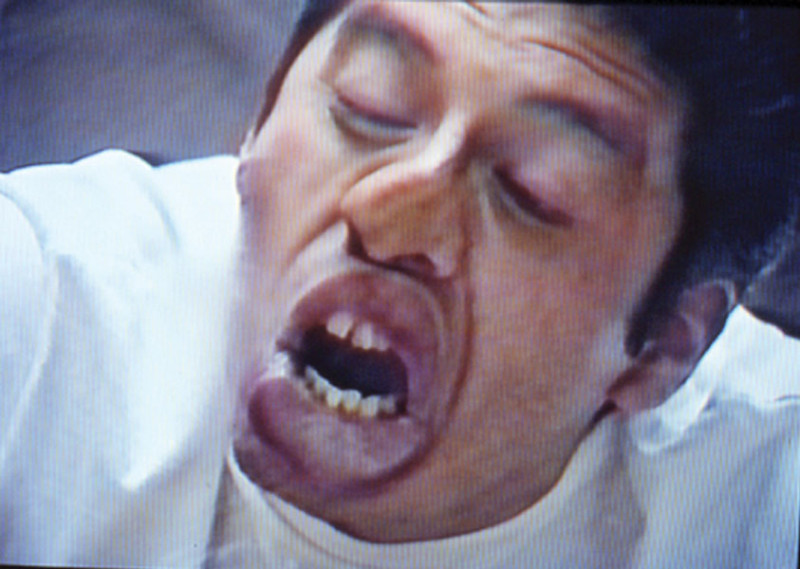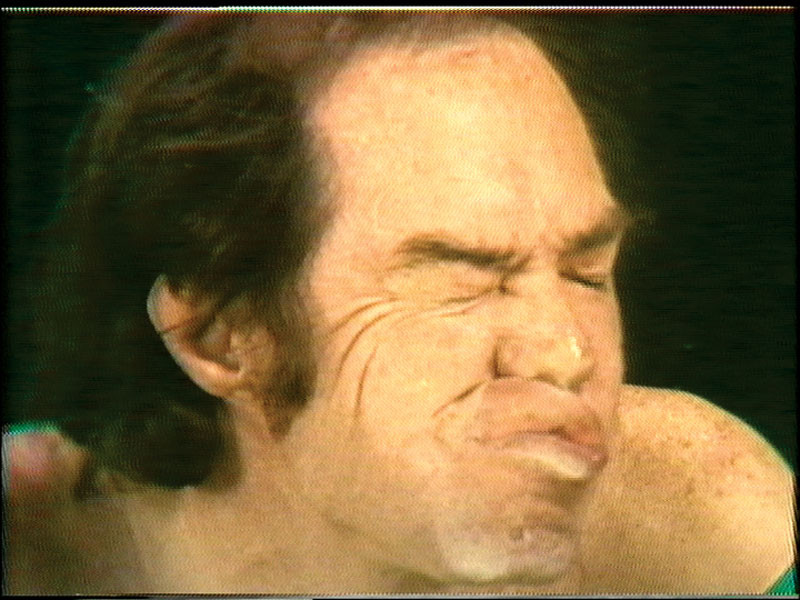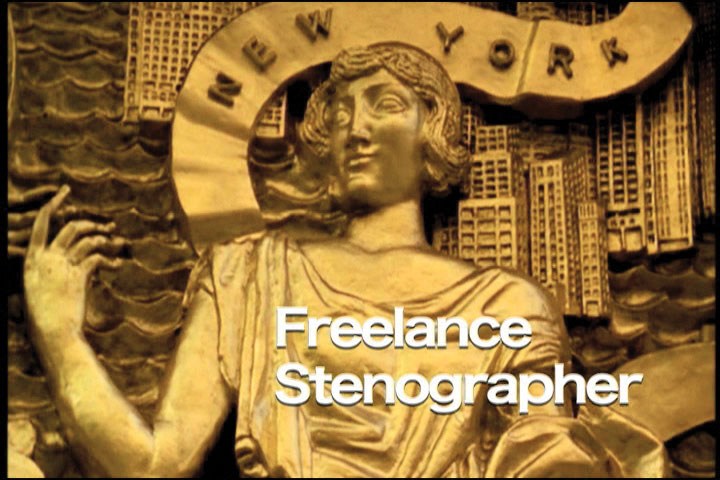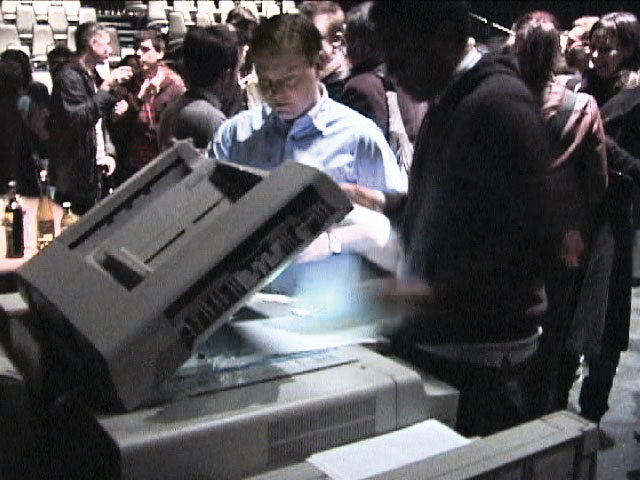[Fall 2010]
by Barbara Clausen
These clips are the first two in a series of six re-enactments by Daniel Guzmán and Luis Felipe Ortega of seminal performances by Terry Fox, Bruce Nauman, and Paul McCarthy, gathered in their video Remake (1994). Ortega recalls his and Guzmán’s motivation to generate their own version of performance history, through the appropriation of what was in fact only available to them as traces and fragments:
When we made Remake, we had been searching data from some 70’s performance artists … . We just had photographic references, and in the best of cases, descriptions of the work: the content, the materials used and duration. Those references came from American and European magazines and books of friends. For us in Mexico, most of those videos, which for other countries are very familiars [sic], were unknown. For that reasons [sic] we decided to re-make those actions in our own … interpretation, appropriating for ourselves some information and generating our particular version.1
Each action that they restaged affirms a sense of seriality and repetition, emblematic of the concepts behind these iconic works. While their efforts to restage McCarthy’s Face Painting (1972) and Glass (1974)2 and Nauman’s Bouncing in the Corner No. 1 (1969) are as close to the original as one can get – they not only catch the right tempo of the movement, but also reconstruct similar, if not identical, camera perspectives – the first two clips differ not only in practice, but in the choice of medium. None of the original performances was witnessed by an audience at the time of its making; each was produced to exist as a video performance or photographic staging.3 The exception was Fox’s one-time performance of Corner Push at the Reese Palley Gallery in San Francisco in 1970, which took place in front of an audience and was never recorded on video. Unlike iconic performances from the 1970s, for which many documents and recordings have survived, for Corner Push only a single photograph exists today.4 What is the most striking when one compares the vintage black-and-white print of Fox’s archive to its video version in Remake is the lack of feeling in the original that is so striking in Ortega’s performance.5
In light of the unattainability of the originals, Ortega and Guzmán’s aim was clearly not to research and produce a video that could be used as an authorized re-enactment of past performances. Rather, they wanted to create an authentic interpretation of a set of instructions for an action that would then be their own. Within this fine balance between fiction and fact, they acknowledged and embraced the possibility of failure through their own circumstances of isolation, as part of the staging of the specific conditions inherent to the originals: “Of course, these actions are talking about a specific condition of the subject and the way how [sic] he can or cannot connect with the rest; they talk about the support it self [sic], but at the same time, they insist in a confronted position: the referent’s systems of interpretation.”6
It is in this spirit that Guzmán and Ortega fully embrace the dialectics between the staging of the documentary and the documentary of the staging. In Remake, they put into action how appropriation is about taking what does not belong and making it your own.7 This is literally spelled out at the end of Remake in their last action, Boca (1992), a piece that Guzmán conceived two years before.8 Inscribing their own work into a greater canon, Boca, in which we see Guzmán probing the malleability of his own mouth with his fingers, was added without comment to the series of masterpieces. They not only created their own version of performance history but added a work of their own to this canon. Guzmán and Ortega prove how appropriation is an activity that continuously changes both the source and the subject.9 Their performance of a history that they were not part of, in both generational and geopolitical terms, has since been granted recognition both as a collaboration and as individual actions in an art world increasingly occupied with the politics of appropriating, re-enacting, and reinventing the history of performance art.10 Remake’s success is emblematic of the rise of Latin American art during the 1990s, a movement engaged with a contemporary conceptual and performative sensibility, reminiscent of the 1970s.11
Since the early 1990s, an awareness has been established in practice, as well as theory, that the ontological status of performance art is a construction, sustained through its contingent nature.12 What Remake – just like the many other re-enactments of famous performances in recent years – proves, is that performance art is process-based and does not disappear after the act.13 In her analysis of the status of documentation of performance art, Jessica Santone has described the representational politics of performance as a dense net of relations, in which the restaging of a document allows the work to circulate from multiple points of authorship: “Each document touches at its root the idea of the original, and then moves out from there, diverging in various ways, connecting to other documents, and producing an accumulation that is best understood collectively.”14
Similarly, Philip Auslander sees the performative not as a singular autonomous act, but as part of a field of cultural activities. He proposes that the cultural archive should be an inspiration for reflection on the phenomenological and cultural conditions that determine our understanding of performance15 – an inspiration that Seth Price and Kelley Walker follow in their performance and video event Freelance Stenographer, which was presented in March 2007 at The Kitchen in New York. At the centre of Freelance Stenographer is not a singular experience or a historic performance, but a myriad of performative events and acts that are conjoined out of various analog and digital archives of popular and high culture. The event started with a video screening, continued with a question-and-answer session that the artists conducted as part of the performance, and ended with the distribution of photocopies of the transcript of the event that the freelance stenographer, Casey Klavi, had recorded on stage throughout the evening.16
Just like the event, the video of Freelance Stenographer has three parts: the first part documents a nascent band of art insiders (Stefan Tcherepnin, Cory Arcangel, and Emily Sundblad) developing a cover version of the 1999 dance hit Better Off Alone that they found on YouTube in their home studio in Brooklyn. Establishing shots of the city begin the video segment, grounding the event in space and time. The second segment shows archival material from 1981 of an Oskar Schlemmer performance, restaged by Debra McCall at The Kitchen. The short clip is layered over with Sonic Youth’s late-1980s hit Teen Age Riot. The third video segment is an excerpt of a work-in-progress documentary by their cameraman, Jason Spingarn-Koff, about the reality behind the avatar lives in the virtual Web world called Second Life. All of the visual material that Price and Walker shot and appropriated was visually manipulated by the artists in post-production, with both subtle and obvious visual effects such as picture-in-picture, lens flares, and video blurbs. At the centre of it all stands the Freelance Stenographer video, which explores the shifting status of performance art through the culmination of three double appropriations: the mixing of pop samples, the collage of archival material with underground music, and a documentary investigation of virtual human relationships. Freelance Stenographer is certainly one of those events that the audience probably had a more difficult time figuring out during the live experience than the historian or critic would have after the event. For critic Tan Lin, the entire event, from the initial framing of the piece to the output, “raised the question of where to insert the production activity of contemporary art into a continually moving analog-to-digital event stream, with The Kitchen itself packaged and repackaged as a form of cultural theater and distribution … . Price and Walker staged their own performance of the archival, or rather, the archival’s status and rights to reproducibility and legibility.”17
While the script of actions in Remake is based on analog reproductions and texts of works that were not available to the Guzmán and Ortega at the time, Price and Walker, more than a decade later, drew their inspiration from an overly accessible and constantly growing archive of digital images and the politics of their distribution on the Internet.18 Both Remake and Freelance Stenographer put into question not only our idea of what an authentic experience is, but also how the experience of performance art’s histories can be tapped into and function. For performance practitioners, the cultural archive has become a topic, a site of exploration, and a medium at the same time.
Performance is a hybrid practice, a medium of many messages. Comparing Remake to its sources reveals how trusted facts of performance history are not stable but fragmentary, process-based, and continuously shifting constructions of not one but many authors and chroniclers – especially today, when most of the works that Guzmán and Ortega refer to are so accessible on the Internet. The fine line between mimicry and critique, when it comes to claims of authenticity and authorship, becomes evident when one considers the fact that Remake can be viewed as a video on Ortega’s Web site,19 while Freelance Stenographer, with its claim of limitless accessibility, is available only as an authorized transcript on Price’s Web site. The visual record remains in the archive of The Kitchen or as a commodity to be sold as a unique work of art. Even though the works were produced more than a decade apart, both reflect upon the idea of authenticity, in all its reality and virtuality, using the performative as a foil for their projections on experience. What makes Freelance Stenographer perhaps as pioneering as Remake, though it was made almost fifteen years later, is its foresight within a discourse that remains deeply engaged in the question of how to preserve the ontological relationship of performance art with its own politics of representation and institutionalization.
1 See Luis Felipe Ortega’s note on Remake, 1994, http://www.luisfelipeortega.com/videos_03_up.html, accessed 6 June 2010.
2 Even though Ortega and Guzmán cite the original as Press (1973), an examination of footage of McCarthy’s work proves that it is in fact Glass (1974).
3 Self-Portrait as a Fountain (1966–67/1970; chromogenic colour print, MCA Collection, Chicago) is in Nauman’s series Eleven Color Photographs (1966–67/70) and shows Nauman spewing water out of his mouth. Nauman appropriated Duchamp’s Fountain (1917), making himself the active object. Nauman is said never to have seen Duchamp’s work, although he admitted that “the information was just sort of in the air.” See Jasmine Moorhead, “MoMA Glorifies Modernist Art of Bruce Nauman,” Yale Herald, 1995; see http://www.yaleherald.com/archive/xix/3.2.95/arts/moma.html, accessed 6 June 2010.
4 According to a 2005 phone conversation that I had with Maria Lootsen and Terry Fox, who passed away in 2008, during the preparation of the exhibition “After the Act: The (Re)Presentation of Performance Art”, which I curated at the Museum of Modern Art Stiftung Ludwig in Vienna in November 2005. It was on this occasion that Ortega and Guzmán decided to present Remake as an installation surrounded by its original sources. The original ten-minute video was split into three separate videos. Each segment consisted of two actions presented on one monitor, next to a selection of the original sources.
5 In the original, we see a person facing the corner of a room. It is not clear if the performer is Fox himself, or a woman who executed the performance perhaps for or with him.
6 See Ortega’s note on Remake.
7 Rahel Jäeggi, “Aneignung braucht Fremdheit,” Texte zur Kunst, vol. 46 (2002): 62.
8 Guzmán’s investigation of the physical limits of his own mouth with his fingers in Boca (Mouth) is, according to the artist, not based on an existing performance. Nevertheless, its aesthetic resembles the archetype of body-based video actions such as Vito Acconci’s Contacts (1971) and Fox’s Tonguings (1970).
9 Rahel Jäeggi, “Aneignung braucht Fremdheit,” p. 62.
10 Melanie Gilligan, “The Beggar’s Pantomime: Melanie Gilligan on Performance and its Appropriations,” Artforum International (Summer 2007); see www.artforum.com.
11 This sensibility was greatly influential for the rising art scene in Mexico during the 1990s and for the conceptual, performative, and minimalist interests of artists Guzmán and Ortega, Santiago Sierra, Teresa Margolles, Carlos Amorales, and Francis Alÿs.
12 I am referring here to a debate that has evolved out an exchange of opinions and essays among Peggy Phelan, Philip Auslander, Amelia Jones and of others. See Peggy Phelan, Unmarked: The Politics of Performance (London and New York: Routledge, 1993); Amelia Jones, ‘Presence’ in Absentia: Experiencing Performance as Documentation – Performance Art Focusing on the Human Body in the Early 1960s Through the 1970s,” Art Journal vol. 56, no. 4 (Winter 1997): 11–18; Philip Auslander, Live Performance in a Mediatized Culture (London and New York: Routledge, 1999).
13 This trend was highlighted in Marina Abramovic’s series of re-enactments titled Seven Easy Pieces, performed at the Guggenheim Museum in New York, 9–15 November, 2005.
14 Jessica Santone, “Marina Abramovic’s Seven Easy Pieces: Critical Documentation Strategies for Preserving Art’s History,” Leonardo, vol. 41, no. 2 (2008): 150–51.
15 Philip Auslander, “The Performativity of Performance Documentation,” in Barbara Clausen (ed.), After the Act: The (Re)Presentation of Performance Art (Nürnberg: Verlag Moderner Kunst, 2006, MUMOK Theory Series 03), p. 33.
16 The script and articles on the event are available to the public on Seth Price’s Web site, http://distributedhistory.
com/freelancesten.html, accessed 6 June 2010.
17 See Tan Lin, “Less Creative Anachronism: Tan Lin on Freelance Stenographer,” Artforum (Summer 2007): 199–200; also available on http://www.distributedhistory.com/tanlin.pdf.
18 See the amazing availability of historical performance material on ubu.web, youtube.com, eai.org, fondation-langlois.org, videodatabank.org, and many other sources on the Internet.
19 See Ortega’s note on Remake.
Barbara Clausen is a curator and art historian working and living in Vienna and Montreal. She is currently a Visiting Research Fellow at the Gail and Stephen A. Jarislowsky Institute for Studies in Canadian Art at Concordia University, Montreal.



